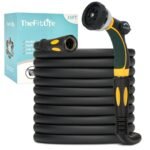Birdwatching, also known as birding, is a fascinating hobby that allows people to appreciate the beauty and diversity of birds in their natural habitats. Whether one is a novice or an experienced birdwatcher, there is always something new to learn and explore in the world of birds.
Engaging in birdwatching is not only a great way to connect with nature, but it also offers numerous benefits such as stress reduction, increased physical activity, and improved mental well-being.
More Birdwatching Articles
Want to learn more about all the great birdwatching products that are available
Bird Seed
- Best Wild Bird Seeds for Attracting a Variety of Birds
- Best Bird Seed for Wild Birds: Bird Friends Will Visit More
- Best Wild Bird Seeds for Attracting a Variety of Birds
- Best Bird Seed for Winter: Guide for Cold-Weather Feeding
- Best Bird Seed for Cardinals: Easily Attract These Birds
Bird Feeder
- Best Bird Feeder Camera: Top 5 Picks To Watch Birds Close-Up
- Best Window Bird Feeder for Bird Watching
- Best Winter Bird Feeders: Food Is Scarce, Help Them Out!
- Best Squirrel Proof Bird Feeder for Your Garden
- Top Pick: The Absolute 3 Best Bird Feeder for Doves!
- Best Bird Feeders for Cardinals: 3 Top Picks for Red Bird
- Best Solar Bird Bath Fountain: Top Picks For Today
- Best Heated Bird Bath: Warm Baths Even In Cold Weather
Bird Accessories
For those who are just starting out in birdwatching, it’s essential to familiarize themselves with different types of birds, their behavior, and habitats. Equipping oneself with a decent pair of binoculars, a field guide, and a notepad for recording observations can greatly enhance the birdwatching experience.
As birdwatchers become more skilled, they can employ various techniques such as listening for bird calls, observing bird behaviors, and even identifying birds based on their flight patterns.
Key Takeaways
- Birdwatching is a rewarding pastime that offers mental and physical health benefits
- Essential tools for beginners include binoculars, a field guide, and a notepad for recording observations
- As birdwatchers gain experience, they can develop various techniques to enhance their skills and enjoyment
Benefits of Birdwatching
Birdwatching, also known as birding, offers numerous benefits not only for bird enthusiasts but also for the general population. In this section, we will explore the main advantages of this engaging activity.
Physical Health
Birdwatching is surprisingly good for our physical health. When we go out in search of birds, we often end up walking, hiking or even jogging. This increases our physical activity, helping us maintain a healthy lifestyle. The exciting pursuit of bird sightings makes these nature walks and workouts enjoyable, making it easier for us to stay consistent in our exercise routine.
Mental Wellness
Birdwatching has been found to have profound positive effects on mental well-being. The act of observing birds and listening to their songs can be a form of mindfulness practice, allowing us to focus on the present moment and escape from our daily stresses.
Being in nature and engaging with birds can have a calming, therapeutic effect on our minds, reducing anxiety and depression symptoms.
Connection to Nature
Birding helps us foster a deeper connection with nature. As we observe various bird species and their behaviors, we become more aware of our environment and the importance of conserving bird populations and their habitats. This heightened appreciation for nature can inspire us to engage in bird conservation efforts and learn about the ecological role that birds play in our world.
Educational Aspects
Being a birdwatcher gives us an opportunity to learn about the fascinating world of birds. By closely observing different species, we can improve our critical thinking skills. Studying bird interactions and behaviors enhances our understanding of bird biology, ecology, and evolution.
As we identify new species and add them to our personal lists, our knowledge of ornithology expands, making us more informed about the world around us.
Community Engagement
Lastly, birdwatching can connect us to a community of like-minded people. Joining birdwatching groups, attending birding events, and sharing our experiences with fellow bird enthusiasts help build social connections and foster a sense of camaraderie.
Together with this community, we can contribute to bird conservation efforts, share valuable information about bird populations, and enjoy the delightful world of birding.
Getting Started with Birdwatching
Equipment Needed
To begin birdwatching, a few essential tools are necessary. First and foremost, we recommend investing in a quality pair of binoculars to get a clear view of the birds you’ll encounter. A camera or spotting scope can be useful for capturing images of the birds you observe. Additionally, field guides, such as The Warbler Guide, can help with identification and understanding bird habits.
Finding the Right Locations
Birdwatching can be enjoyed almost anywhere, but certain locations are particularly rich in bird diversity. Start close to home by exploring your local parks and nearby natural areas. To maximize bird sightings, consider visiting known birding hotspots and migration routes. Joining local birdwatching clubs can also assist you in discovering the best locations.
Understanding Bird Behavior
To truly appreciate birdwatching, it’s essential to understand bird behavior. Birds have unique songs, calls, and habits that can sometimes reveal their presence before they are visible. Listening and observing are key skills that improve with practice. Having a field guide on hand can also enhance your understanding of bird behavior and species identification.
Best Times for Birdwatching
Timing is crucial when it comes to birdwatching. Early morning hours are generally the most productive, as many bird species are most active at this time. Additionally, seasonality plays a large role as different species may be present during migrations or breeding periods.
Keep in mind that weather conditions can also impact bird activity, with some birds being more active on overcast days.
Ethical Considerations
As birdwatchers, we must respect both nature and the birds we observe. To minimize our impact, it’s important to follow ethical guidelines, such as not disturbing nests, not using playback devices to attract birds, and keeping a respectful distance to avoid stressing the birds. By observing these guidelines, we can ensure that birdwatching remains an enjoyable and sustainable hobby for all.
Techniques and Skills
Basic Identification Techniques
When starting as a birdwatcher, it’s essential to master some basic identification techniques. One useful approach is observing the size and shape of birds, as well as taking note of their distinct color patterns. A quality field guide, such as the ones recommended by Audubon New York, can help you narrow down and identify species you don’t recognize.
Bird Calls and Songs
In addition to appearance, the sounds that birds make can be key to their identification. The Cornell Lab of Ornithology is an excellent resource for learning about bird calls and songs. Familiarizing yourself with the vocalizations of the species in your area will greatly improve your birding skills.
Observational Skills
Observational skills are paramount in birdwatching. Developing the ability to spot and track birds through both binoculars and scopes will enhance your experience. As mentioned by Wild Bird Lady, birdwatchers often use a combination of visual and auditory senses to observe and understand bird behavior in their natural habitat.
Binoculars and Scopes:
- Choose a pair in the $100-$200 range for good optics.
- Try different optics at a store before purchasing.
- Learn to focus quickly and efficiently.
- Practice using both eyes and adjusting the focus.
Photography Tips
Many birdwatchers also enjoy capturing the beauty of the birds they observe. Here are some tips for bird photography:
- Use a camera with a good zoom lens.
- Avoid using flash, as it can startle the birds.
- Be patient and learn to anticipate bird movements.
- Study their behavior and habitat to know where to find them.
Recording and Documentation
Recording your birdwatching experiences can be both enjoyable and educational. Whether through note-taking, voice recording, or photography, documenting your observations will help you hone your identification skills and contribute valuable data to the birding community. Remember to respect bird habitats and follow ethical guidelines when capturing and sharing your finds.
Birdwatching Communities and Culture
Birdwatching Clubs and Societies
Throughout the country, numerous birdwatching clubs and societies help bind birders together. These organizations, such as the American Birding Association, provide a platform for people to share their passion for birdwatching and expand their knowledge about birds.
By joining a local birdwatching club, you can learn from experienced birders, participate in birdwatching outings, and contribute to conservation efforts within your community.
Citizen Science Projects
We should never underestimate the power of collaborative efforts. Citizen science projects enable birders to contribute to the scientific understanding and conservation of birds. An excellent example is eBird, a project by the Cornell Lab of Ornithology and the National Audubon Society.
By submitting their bird sightings, birders can create valuable data to help researchers and conservationists monitor bird populations and distributions worldwide.
Festivals and Events
Throughout the year, numerous birdwatching festivals and events are held across the United States and around the world. These gatherings provide opportunities for birders to come together, share experiences, and enhance their birdwatching skills.
Some prominent events include the Great Backyard Bird Count, the Warbler and Wildflower Festival, and the Rio Grande Valley Birding Festival.
Influential Books and Authors
In the world of birdwatching, some books and authors have left an indelible mark on the community. Among them are “The Sibley Guide to Birds” by David Allen Sibley and “The Crossley ID Guide” by Richard Crossley, which serve as indispensable resources for bird identification.
Additionally, Roger Tory Peterson’s “A Field Guide to the Birds” revolutionized birdwatching by introducing user-friendly field guides for easy identification in the early 20th century.
Online Resources and Mobile Apps
Today, we are fortunate to have a wealth of online resources and mobile apps that make birdwatching more accessible than ever. Websites such as All About Birds provide comprehensive information about bird species, behavior, and habitats.
Apps like Merlin Bird ID and iBird Pro offer user-friendly guides and bird identification features. By exploring such tools, we can become more knowledgeable birders and foster a deeper appreciation for the avian world around us.
Conservation and Environmental Concerns
Importance of Bird Conservation
Birds play a crucial role in maintaining the balance of ecosystems, supporting biodiversity, and contributing to our quality of life. With over 500 native bird species threatened with extinction across the Americas, and nearly 300 of 750 native bird species in the United States declining in population, it is our responsibility to protect and conserve these species.
Habitat Preservation
Protecting the habitats of various bird species is essential to their survival. Many birds rely on specific habitats for nesting, feeding, and migration. We must work to preserve and restore these habitats to ensure the long-term survival of bird populations.
This can be achieved through efforts such as land preservation, sustainable land use practices, and habitat restoration projects. By focusing on conserving habitat that benefits multiple bird species, we can maximize the abundance and diversity of bird species in the environment.
Ethical Tourism
Birdwatching has grown in popularity, offering the potential for increased awareness of conservation challenges and providing economic incentives for local communities to protect bird populations and habitats.
However, we must ensure that birdwatching tourism is conducted ethically and responsibly. This includes setting guidelines for birdwatchers to minimize disturbance to birds, respecting local customs and traditions, and promoting sustainable practices within the birdwatching industry.
To make birdwatching activities more conservation-oriented, we can:
- Encourage birdwatching tours and trips that support local conservation initiatives
- Promote birdwatching as an educational opportunity to learn about the environment and conservation
- Emphasize the need for responsible birdwatching etiquette, such as keeping a safe distance from nests and limiting the use of playback recordings
Role of Birdwatchers in Conservation Efforts
Birdwatchers can play a significant role in supporting conservation efforts. By actively participating in citizen science projects, such as monitoring programs and bird surveys, birdwatchers can contribute valuable data to help guide conservation decisions.
Moreover, the Birds of Conservation Concern 2021 report identified 269 species of birds that require proactive attention from researchers and conservationists, and birdwatchers can assist in these efforts by reporting sightings and sharing information.
Furthermore, birdwatchers can advocate for bird conservation by promoting awareness of declining bird populations and supporting the work of organizations dedicated to protecting birds and their habitats.
Through these actions, we, as birdwatchers, can actively contribute to the conservation of birds and their environments, ensuring their survival for future generations to appreciate and enjoy.
Travel and Global Birdwatching
Popular Birdwatching Destinations Around the World
From the lush rainforests of Costa Rica to the mesmerizing landscapes of Africa, the world is full of amazing birdwatching destinations. In North America, we can enjoy a diverse range of bird species, including warblers, sparrows, and shorebirds.
One of the best bird watching destinations globally is Bogarin Trail in Costa Rica. Another remarkable birding location is Assam Lingzey in India. However, there are numerous world-class birdwatching spots, such as South Georgia Island, known for its half a million king penguins.
Travel Tips for Birdwatchers
Birdwatching trips require planning and preparation. Here are some tips to make the most of your birding adventure:
- Research: Before traveling, research your destination’s bird species and prime birdwatching locations.
- Guides: Consider hiring a local guide experienced in birding for the best experience.
- Equipment: Invest in quality binoculars, cameras, and guidebooks for accurate identification.
- Timing: Plan your trip around peak birding seasons and times of day when birds are most active.
Cultural Considerations
Birdwatching may involve visiting remote communities. It’s essential to be respectful and considerate of local customs and traditions. Here are some guidelines to follow:
- Be aware of local etiquette and dress codes.
- Support local economies by visiting lodges, shops, and restaurants.
- Follow any bird-sensitive rules or guidelines provided by local authorities or conservation groups.
- Ask permission before photographing people or private property.
Health and Safety Tips
Now that you’re ready to embark on your birdwatching journey, there are some health and safety measures to consider:
- Always observe birds from a safe distance and avoid disturbing their behavior or habitat.
- Protect yourself from insect-borne diseases, such as malaria, by wearing appropriate clothing and applying insect repellent.
- Ensure your vaccinations are up-to-date for the region you’re visiting.
- Stay hydrated and carry essential medications with you.
- Follow any safety guidelines provided by your guide or local authorities, especially in wilderness areas.
Specialized Birdwatching Topics
Urban Birdwatching
As bird enthusiasts, we know it’s not always possible to venture into the wild for birdwatching. That’s where urban birdwatching comes in. Cities are home to many bird species that have adapted to live among concrete jungles.
Parks, green spaces, and waterfronts can be great locations to observe diverse species. We can spot common birds like pigeons and sparrows, or more elusive species like peregrine falcons, which thrive in city environments. Keep an eye and ear out for birds that seek refuge in urban landscapes.
Night-time Birdwatching
Many birds are active during the night, and these species offer a unique birdwatching experience. Owls, nighthawks, and nightjars are just a few of the nocturnal birds we can observe. To maximize our chances of spotting these elusive creatures, we should plan excursions around the new moon, when the sky is darkest.
A good flashlight and a warm jacket are essential gear. Remember to tread quietly and use our ears to detect bird calls and movements in the dark.
Birdwatching for Children and Families
Birdwatching is a fantastic activity for families to enjoy together. When introducing children to birdwatching, it’s essential to keep their interest levels high. Therefore, we recommend:
- Choosing locations with high bird activity
- Starting with common, easily identifiable species
- Engaging children in bird identification using field guides
- Incorporating birdwatching with other outdoor activities, such as hiking or picnicking
Rare and Endangered Birds
For experienced birdwatchers, seeking rare or endangered species adds an extra level of excitement. These birds can be found in specific regions or habitats, making finding them a challenging but rewarding experience.
As responsible birdwatchers, we must ensure our activities do not harm or disturb these fragile creatures. We can participate in conservation efforts and adhere to ethical birdwatching guidelines to protect the species we cherish the most.
Overall, specialized birdwatching topics provide a myriad of opportunities for us to expand our skills, knowledge, and experiences as birdwatchers. From city streets to starlit forests, our adventures in birdwatching are boundless.
Challenges and Controversies
Accessibility Issues
In recent years, there has been a growing concern over the lack of diversity and accessibility within the birdwatching community. Many outdoor activities, including birdwatching, tend to attract a specific demographic – older, white, and male1.
We need to ensure that birdwatching is accessible and inclusive to people of all ages, ethnicities, and genders. Efforts should be made to increase awareness and remove any barriers that may exclude certain groups from participating in this enriching hobby.
Impact of Technology
The use of technology in birdwatching has become increasingly popular, resulting in both positive and negative consequences. On one hand, technology can aid in the identification and recording of bird sightings, making it easier for even novice birders to learn and participate in the activity.
However, there is also a concern that certain technology could potentially be harmful to birds. For example, some birders use recorded bird calls to lure birds closer, but this practice can be extremely detrimental to the birds’ natural behavior2. As a community, we must find a balance between using technology responsibly and respecting the well-being of our avian subjects.
Disputes within the Community
As with any hobby or interest group, birdwatching is not immune to disagreements and disputes among its members. In recent years, heated debates have arisen within the birding community regarding various tactics and practices3.
Some common points of contention are the ethical use of playback calls, competition among birders, and the sharing of sensitive information about rare or endangered species. It’s essential that we address these disputes responsibly and collaboratively to preserve the spirit of unity and respect for nature that birdwatching fosters.
Legal and Regulatory Concerns
Birdwatching is subject to laws and regulations that govern the protection of wildlife and public spaces. While most birders respect these rules, there have been instances of individuals breaking laws in pursuit of their passion.
These actions may include entering restricted areas, disturbing nesting sites, or violating other regulations4. As a birdwatching community, we must respect and abide by these laws to protect the birds we love and maintain the trust and cooperation of the public agencies that manage these natural habitats.
Footnotes
- https://www.cnn.com/2020/05/27/us/birdwatching-black-christian-cooper/index.html ↩
- https://www.nytimes.com/2021/02/16/nyregion/birding-central-park.html ↩
- https://theconversation.com/us/topics/birdwatching-7493 ↩
- https://www.birdnote.org/explore/tune-kids-nature-resources-educators/birdwatching-through-lens-diversity ↩
Future Trends and Developments
Technological Advances
As technology continues to evolve, so does its impact on the world of birdwatching. The use of smartphone apps and online platforms has already transformed the way birding enthusiasts share their observations and participate in citizen science projects.
In the near future, we expect to see further integration of cutting-edge technology, such as machine learning and augmented reality, to aid in bird identification and pattern recognition.
Drones equipped with high-resolution cameras and noise-cancelling technology may also become more prevalent in birdwatching, allowing us to observe birds from greater distances without disturbing their natural habitats.
Growing Community Involvement
Birdwatching has experienced a surge in popularity throughout the pandemic, as people turned to nature for solace and mental well-being. We believe this trend is more than just a passing phase, with interest in birding remaining higher than pre-pandemic levels.
As a result, we expect to see increased community involvement in bird conservation efforts, such as habitat restoration and the creation of bird-friendly spaces in urban areas.
We also anticipate a rise in educational programs and birdwatching clubs, promoting avian appreciation in younger generations and fostering long-lasting connections with nature.
Climate Change and Its Impact on Birdwatching
Climate change has already begun affecting bird populations worldwide, altering migration patterns, breeding seasons, and ecosystems. As shifting climatic conditions increasingly impact bird behavior, we must adapt our birdwatching practices to better understand these developments.
To achieve this, we will need:
- Enhanced Monitoring Methods: By employing advanced technologies and improved data collection techniques, we can track changes in bird populations and movements more accurately, helping us anticipate species’ responses to climate change.
- Adaptive Management: As climate change continues to reshape ecosystems, we should consider revising management plans and conservation strategies to better protect birds and their habitats.
- Collaborative Knowledge Sharing: We must cultivate a spirit of cooperation among birdwatchers, researchers, and conservationists, pooling our resources and knowledge to address the challenges of climate change on avian populations.
As we face these future trends and developments in the world of birdwatching, our collective efforts to appreciate, study, and conserve our precious avian friends will only become more crucial.
Frequently Asked Questions
What equipment is essential for birdwatching?
When starting with birdwatching, the basic equipment you’ll need includes a reliable pair of binoculars and a field guide. Binoculars help bring distant birds into focus, allowing you to observe their unique features and behaviors more closely.
A field guide, on the other hand, helps you identify the birds you encounter and provides information about their habitat, behavior, and vocalizations. As you gain more experience, you may want to invest in a spotting scope and a camera for capturing those special birdwatching moments.
What are the benefits of bird watching?
Birdwatching offers multiple benefits for people of all ages. It encourages us to connect with nature, improving our overall well-being and reducing stress. Birdwatching also helps develop patience, observational skills, and a greater appreciation for wildlife and the environment.
Additionally, many birders find a sense of community and camaraderie by participating in local birdwatching groups and events.
What are some popular birdwatching websites?
There are several reputable websites that can help you with your birdwatching journey. All About Birds provides detailed information about bird species, their habitats, and birding basics. eBird is a great platform to record your bird sightings, explore data shared by other birders, and find birdwatching hotspots near you.
Audubon offers a wealth of information about bird conservation, news, and events, as well as a useful FAQ section for birdwatchers.
What is the difference between birding and bird watching?
The terms birding and bird watching are often used interchangeably, and both refer to the activity of observing birds in their natural habitat. However, some people make a distinction between the two, arguing that birding is more focused on actively searching for and identifying different bird species, while bird watching implies a more relaxed, casual observation of birds.
Is bird watching beneficial for mental health?
Yes, bird watching can have a positive impact on mental health. Engaging with nature has been shown to reduce stress, anxiety, and depression, while also improving attention and cognitive function. Birdwatching provides a unique opportunity to immerse oneself in a natural environment, fostering mindfulness and a sense of calm.
Which movies are based on birdwatching?
There are several movies that revolve around birdwatching or feature birdwatchers as central characters. One popular example is “The Big Year” (2011), a comedy-drama starring Steve Martin, Jack Black, and Owen Wilson, which follows three avid birders competing to spot the most bird species in North America within a calendar year.
Other birdwatching-related films include “A Birder’s Guide to Everything” (2013), a coming-of-age story about a teenage birdwatcher, and “Birders: The Central Park Effect” (2012), a documentary that explores the diverse community of birdwatchers in New York City’s Central Park.

Meet Kevin Goodell, your outdoor adventure coach! With a passion for nature ignited in childhood, Kevin brings a wealth of experience and expertise to simplify tough outdoor skills. As a U.S. Army veteran and former Sergeant, he has honed his leadership and teamwork abilities while developing a deep love for the great outdoors.
Kevin’s dedication to outdoor activities spans biking, birdwatching, national park trips, and archery/golf. With his friendly and approachable demeanor, he is committed to guiding individuals of all ages and skill levels towards unforgettable outdoor experiences.
Harnessing his extensive knowledge and personal achievements, Kevin is your go-to resource for learning and enjoying various outdoor pursuits. Whether you seek thrilling adventures or serene nature escapes, Kevin’s professional yet friendly approach will ensure an engaging and informative experience. Embark on your next outdoor adventure with Kevin Goodell and embrace the beauty of nature like never before.






